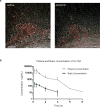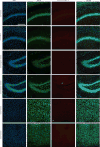Targeting neuronal activity-regulated neuroligin-3 dependency in high-grade glioma
- PMID: 28959975
- PMCID: PMC5891832
- DOI: 10.1038/nature24014
Targeting neuronal activity-regulated neuroligin-3 dependency in high-grade glioma
Abstract
High-grade gliomas (HGG) are a devastating group of cancers, and represent the leading cause of brain tumour-related death in both children and adults. Therapies aimed at mechanisms intrinsic to glioma cells have translated to only limited success; effective therapeutic strategies will need also to target elements of the tumour microenvironment that promote glioma progression. Neuronal activity promotes the growth of a range of molecularly and clinically distinct HGG types, including adult and paediatric glioblastoma (GBM), anaplastic oligodendroglioma, and diffuse intrinsic pontine glioma (DIPG). An important mechanism that mediates this neural regulation of brain cancer is activity-dependent cleavage and secretion of the synaptic adhesion molecule neuroligin-3 (NLGN3), which promotes glioma proliferation through the PI3K-mTOR pathway. However, the necessity of NLGN3 for glioma growth, the proteolytic mechanism of NLGN3 secretion, and the further molecular consequences of NLGN3 secretion in glioma cells remain unknown. Here we show that HGG growth depends on microenvironmental NLGN3, identify signalling cascades downstream of NLGN3 binding in glioma, and determine a therapeutically targetable mechanism of secretion. Patient-derived orthotopic xenografts of paediatric GBM, DIPG and adult GBM fail to grow in Nlgn3 knockout mice. NLGN3 stimulates several oncogenic pathways, such as early focal adhesion kinase activation upstream of PI3K-mTOR, and induces transcriptional changes that include upregulation of several synapse-related genes in glioma cells. NLGN3 is cleaved from both neurons and oligodendrocyte precursor cells via the ADAM10 sheddase. ADAM10 inhibitors prevent the release of NLGN3 into the tumour microenvironment and robustly block HGG xenograft growth. This work defines a promising strategy for targeting NLGN3 secretion, which could prove transformative for HGG therapy.
Conflict of interest statement
The authors declare competing financial interests: M.M. and H.S.V. declare that Stanford University filed a patent application (15/011260) related to this work.
Figures












Comment in
-
Cancer: Drain the swamp to beat glioma.Nature. 2017 Sep 28;549(7673):460-461. doi: 10.1038/nature24141. Epub 2017 Sep 20. Nature. 2017. PMID: 28959957 No abstract available.
-
Anticancer therapy: Holding the thought.Nat Rev Drug Discov. 2017 Oct 30;16(11):751. doi: 10.1038/nrd.2017.216. Nat Rev Drug Discov. 2017. PMID: 29081517 No abstract available.
References
Publication types
MeSH terms
Substances
Grants and funding
LinkOut - more resources
Full Text Sources
Other Literature Sources
Molecular Biology Databases
Miscellaneous

